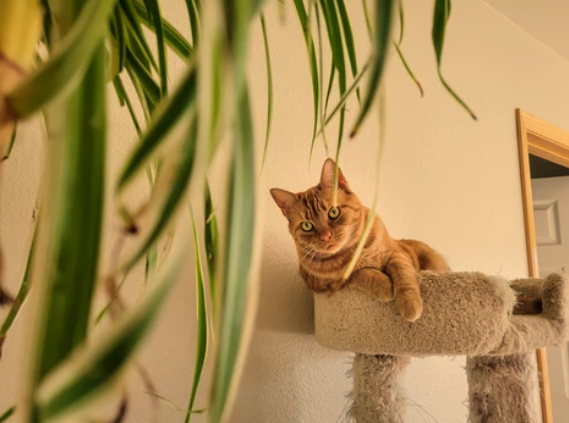As a loving cat owner, ensuring the safety and well-being of your feline friend is undoubtedly a top priority.
You’ve likely heard about various household plants being potentially harmful to cats, and one plant that often raises questions is the spider plant (Chlorophytum comosum).
In this blog post, we’ll dive into the truth behind whether spider plants are poisonous to cats, helping you make informed decisions about indoor greenery and your beloved pet.
The Spider Plant: An Overview
The spider plant, known for its gracefully arching leaves and easy maintenance, is a popular choice among plant enthusiasts. Its lush, green foliage can add a touch of nature to your living space, making it an attractive option for both aesthetic and air-purifying qualities. However, the question of whether this plant poses a threat to cats has sparked some concern.

Spider plants have long been a staple in households, adorning windowsills and shelves with their vibrant green foliage and graceful arching leaves.
However, their popularity has also sparked debates among pet owners, especially those who share their homes with curious and sometimes mischievous feline companions.
The central question at the heart of this debate: are spider plants poisonous to cats?
Cats, with their inquisitive nature, often explore their surroundings by investigating new scents, textures, and tastes.
This behavior sometimes leads them to interact with household plants, including the beloved spider plant.
As responsible pet owners, it’s crucial to address any potential risks these interactions might pose to our feline friends.
Are spider plants poisonous to cats?

Are Spider Plants Poisonous to Cats
The good news is that spider plants are generally considered to have a low level of toxicity.
According to the American Society for the Prevention of Cruelty to Animals (ASPCA), spider plants are classified as non-toxic to cats.
This means that while the plant might cause minor gastrointestinal discomfort if ingested, it is not likely to result in severe poisoning or life-threatening conditions for your feline friend.
Effects of Ingestion
In most cases, if a cat nibbles on or ingests a small amount of spider plant material, the potential effects are mild and temporary. Common symptoms might include:
- Vomiting: Your cat may experience vomiting as a natural response to the plant’s minor irritants.
- Drooling: Some cats might drool due to the plant’s taste and texture.
- Upset Stomach: Gastrointestinal discomfort, like diarrhea, might occur but usually resolves on its own.
These symptoms, while uncomfortable, are generally short-lived and don’t lead to severe health issues. However, individual sensitivities can vary among cats, so it’s still essential to remain vigilant.

Rare Occurrences of Severe Reactions
Instances of severe poisoning resulting from spider plant ingestion are rare and unlikely.
The majority of cats may experience minor discomfort at most, with their bodies naturally expelling the ingested plant material through vomiting or diarrhea.
The odds of life-threatening complications are minimal.
Preventive Measures
Even though spider plants are not highly toxic to cats, it’s still a good idea to take preventive measures to ensure your pet’s safety:
- Placement: If you have a curious and nibble-prone cat, consider placing your spider plant in an area that is less accessible to them. Hanging the plant or using elevated shelves can help keep it out of reach.
- Supervision: While many cats will show little interest in spider plants, it’s best to keep an eye on their behavior around the plant to prevent excessive chewing.
- Distracting Alternatives: Provide your cat with safe and appropriate chewing options, such as cat grass or catnip, to divert their attention away from the spider plant.
- Training: Basic training, such as teaching your cat to avoid certain areas or objects, can also contribute to their safety around plants.
Warp Up
In the realm of pet-safe plants, the spider plant stands out as a relatively harmless choice for cat owners.
While it’s true that ingesting this plant might lead to minor gastrointestinal discomfort, the overall risk of severe poisoning is low.
As responsible pet owners, it’s crucial to strike a balance between creating a green and inviting living space and ensuring your cat’s well-being.
With proper preventive measures and a watchful eye, you can enjoy the beauty of spider plants while keeping your feline friend safe and sound.
Related Read: Office Plants




